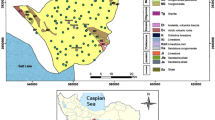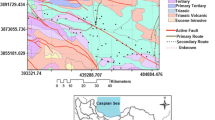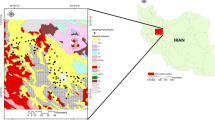Abstract
Geostatistical tools have been increasingly applied to compile spatial distribution maps of groundwater quality. Results of geostatistics can be helpful for decision-makers to carry out appropriate remedial actions to sustain the quality of groundwater sources. The main purpose of this paper is to assess the groundwater hydrogeochemistry of Tehran-Karaj plain aquifer, Iran, by a forward geostatistical method and an inverse geostatistical method called sequential Gaussian simulation. Seven important hydrogeochemical properties of the aquifer including total dissolved solids, sodium adsorption ratio, electrical conductivity, sodium, total hardness, chloride, and sulfate were analyzed and compiled geostatistically. Data were taken from 137 well samples in 2016. After data normalization, variography was compiled, and experimental variograms were plotted; then, the best theoretical model was fitted on each variogram based on the minimum residual sum of squares. Cross-validation was used to determine the accuracy of parameters related to the variograms. Estimation maps of the groundwater hydrogeochemistry were prepared, and the estimation variance map was drawn to assess the accuracy of estimation in each estimated point. Forward geostatistical methods are subjected to smoothing, while inverse geostatistical methods are not subjected to this problem. The results of this study revealed that the utilized inverse geostatistical methods called simulation algorithms are more accurate than forward methods. Eventually, estimation maps of each parameter, as well as error maps, were compiled, and critical regions have been proposed according to the simulated maps.









Similar content being viewed by others
References
Adhikary PP, Dash CJ, Chandrasekharan H, Bej R (2011) Indicator and probability kriging methods for delineating cu, Fe, and Mn contamination in groundwater of Najafgareh block, Delhi, India. Environ Monit Assess 176:663–676
Asghari O, Soltani F, Amnieh HB (2009) The comparison between sequential Gaussian simulation (SGS) of Choghart ore deposit and geostatistical estimation through ordinary kriging. Aust J Basic Appl Sci 3:330–341
Barca E, Passarella G (2008) Spatial evaluation of the risk of groundwater quality degradation. A comparison between disjunctive kriging and geostatistical simulation. Environ Monit Assess 137:261–273
Bastante FG, Ordóñez C, Taboada J, Matías JM (2008) Comparison of indicator kriging, conditional indicator simulation and multiple-point statistics used to model slate deposits. Eng Geol 98:50–59
Chandan KS, Yashwant BK (2017) Optimization of groundwater level monitoring network using GIS-based geostatistical method and multi-parameter analysis: a case study in Wainganga sub-basin, India. Chin Geogr Sci 27:201–215
Chilès JP, Delfiner P (2012) Wiley series in probability and statistics. In: Geostatistics: Modeling Spatial Uncertainty. Wiley, Hoboken, pp 705–714
Chitsazan M, Tabari MMR, Eilbeigi M (2017) Analysis of temporal and spatial variations in groundwater nitrate and development of its pollution plume: a case study in Karaj aquifer. Environ Earth Sci 76:391
Cinnirella S, Buttafuoco G, Pirrone N (2005) Stochastic analysis to assess the spatial distribution of groundwater nitrate concentrations in the Po catchment (Italy). Environ Pollut 133:569–580
Clark I (1979) Practical geostatistics, vol 3. Applied Science Publishers, London, p 129
Delbari M, Motlagh MB, Kiani M, Amiri M (2013) Investigating spatiotemporal variability of groundwater quality parameters using geostatistics and GIS. IJBAS 4:3623–3632
Deutsch CV, Journel AG (1998) GSLIB: Geostatistical software library and User’s guide, 2nd edn. Oxford University Press, New York
Dungan JL (1999) Conditional simulation: an alternative to estimation for achieving mapping objectives. In: Spatial statistics for remote sensing. Springer, Dordrecht, pp 135–152
Esfahani NM, Asghari O (2013) Fault detection in 3D by sequential Gaussian simulation of rock quality designation (RQD). Arab J Geosci 6:3737–3747
Golekar R, Bartakke VV, Patil SN, Baride MV (2014) Groundwater quality assessment from Tarali river sub-basin of Krishna river basin, western Maharashtra (India). Int J Adv Geosci 2:8–12
Jalali M, Karami S, Fatehi Marj A (2016) Geostatistical evaluation of spatial variation related to groundwater quality database: case study for Arak plain aquifer, Iran. Environ Model Assess 21:707–719
Jalali M, Karami S, Marj AF (2019) On the problem of the spatial distribution delineation of the groundwater quality indicators via multivariate statistical and geostatistical approaches. Environ Monit Assess 191:323
Jolly WM, Graham JM, Michaelis A, Nemani R, Running SW (2005) A flexible, integrated system for generating meteorological surfaces derived from point sources across multiple geographic scales. Environ Model Softw 20:873–882
Journel AG, Huijbregts CJ (1978) Mining Geostatistics. Academic, London
Karami S, Madani H, Katibeh H, Marj AF (2018) Assessment and modeling of the groundwater hydrogeochemical quality parameters via geostatistical approaches. Appl Water Sci 8:23
Kevin J, Jay M, Ver H, Krivoruchko K, Neil L (2003) Using ArcGIS® Geostatistical analyst. ESRI (Environmental Systems Research Institute), Redlands
Krige DG (1996) A practical analysis of the effects of spatial structure and of data available and accessed, on conditional biases in ordinary kriging. Geosta Wollon 96:799–810
Lin YP, Tan YC, Rouhani S (2001) Identifying spatial characteristics of transmissivity using simulated annealing and kriging methods. J Environ Geol 41:200–208
McBratney AB, Webster R (1986) Choosing functions for semi-variograms of soil properties and fitting them to sampling estimates. J Soil Sci 37:617–639
Medici G, West LJ, Banwart SA (2019) Groundwater flow velocities in a fractured carbonate aquifer-type: implications for contaminant transport. J Contam 222:1–16
Mohammadi K, Niknam R, Majd VJ (2009) Aquifer vulnerability assessment using GIS and fuzzy system: a case study in Tehran–Karaj aquifer, Iran. J Environ Geol 58:437–446
Mouser PJ, Rizzo DM (2004) Evaluation of geostatistics for combined hydrochemistry and microbial community fingerprinting at a waste disposal site. In: Critical Transitions in Water and Environmental Resources Management, pp 1–11
Nasrabadi T, Maedeh PA (2014) Groundwater quality assessment in southern parts of Tehran plain, Iran. Environ Earth Sci 71:2077–2086
Perttunen CD, Stuckman BE (1992) The normal score transformation applied to a multi-univariate method of global optimization. J Glob Optim 2:167–176
Puttiwongrak A, Suteerasak T, Mai PK, Hashimoto K, Gonzalez JC, Rattanakom R, Prueksakorn K (2019) Application of multi-monitoring methods to investigate the contamination levels and dispersion of Pb and Zn from tin mining in coastal sediments at Saphan Hin, Phuket, Thailand. J Clean Prod 218:108–117
Ramazi H, Jalali M (2015) Contribution of geophysical inversion theory and geostatistical simulation to determine geoelectrical anomalies. Stud Geophys Geod 59:97–112
Reyes-López JA, Ramírez-Hernández J, Lázaro-Mancilla O, Carreón-Diazconti C, Garrido MML (2008) Assessment of groundwater contamination by landfill leachate: a case in México. J Waste Manag 28:S33–S39
Rezaee H, Asghari O, Koneshloo M, Ortiz JM (2014) Multiple-point geostatistical simulation of dykes: application at Sungun porphyry copper system, Iran. Stoch Env Res Risk A 28:1913–1927
Rossi ME, Deutsch CV (2014) Mineral resource estimation. Springer Science & Business Media, Citado
Sabzban F, Fatemi Aghda SM (2011) Predicting of Karaj plain subsidence using PMWIN software. 15th Conference of Tarbiat Moallem University on Geology, Tehran, Iran, December 14–15, 7 p
Sajil Kumar PJ, Jegathambal P, James EJ (2011) Multivariate and Geostatistical analysis of groundwater quality in Palar River basin. Int J Geol 5:108–119
Snowden DV (2001) Practical interpretation of mineral resource and ore reserve classification guidelines. Mineral Resource and Ore Reserve Estimation-The Guide to Good Practice, AUSIMM 23:653–660
Soltani F, Afzal P, Asghari O (2014) Delineation of alteration zones based on sequential Gaussian simulation and concentration–volume fractal modeling in the hypogene zone of Sungun copper deposit, NW Iran. J Geochem Explor 140:64–76
Talebi H, Asghari O, Emery X (2014) Simulation of the lately injected dykes in an Iranian porphyry copper deposit using the plurigaussian model. Arab J Geosci 7:2771–2780
Tavassol SF, Gopalakrishna GS (2014) Pb contamination and analysis of aquifer in Karaj plain, Alborz Province, Iran using GIS-based DRASTIC model. BEPLS 3:263–271
Tavassol SF, Ashamanjari KG, Chandra KS (2016) Chemistry of the groundwater in KARAJ plain, ALBORZ province, IRAN. IJGES 2:31–42
Theodossiou N, Latinopoulos P (2006) Evaluation and optimization of groundwater observation networks using the kriging methodology. Environ Model Softw 21:991–1000
Torcal F, Posadas AM, Chica M, Serrano I (1999) Application of conditional geostatistical simulation to calculate the probability of occurrence of earthquakes belonging to a seismic series. Geophys J Int 139:703–725
Uyan M, Cay T (2010) Geostatistical methods for mapping groundwater nitrate concentrations. In: 3rd International Conference on cartography and GIS
Webster R, Oliver M (2001) Local estimation or prediction: kriging. In: Geostatistics for environmental scientists, 2nd edn. Wiley, London, pp 153–194
Wijewardana NS, Galagedara LW, Mowjood MIM (2012) Assessment of groundwater contamination by landfill leachate with ground penetrating radar. In: 14th international conference on ground-penetrating radar (GPR), IEEE, pp 728–732
Acknowledgments
The authors would like to thank the Iran Water Resources Management Company for collecting, analyzing, and providing the data. Also, we fully appreciate the anonymous reviewers for their professional reviewing. Their precious comments have improved the scientific quality of the paper. We thank the editorial board of the Arabian Journal of Geosciences for their consideration.
Author information
Authors and Affiliations
Corresponding author
Additional information
Responsible editor: Ozgur Kisi
Appendix
Appendix
Histogram of the residuals calculated by Jackknife kriging illustrating that the utilized method is unbiased. This process can be used to check if the method is unbiased. The unbiased method should carry three criteria: (1) showing a normal distribution (2) having a mean close to zero (c) having a variance near one or less
Rights and permissions
About this article
Cite this article
Karami, S., Jalali, M., Katibeh, H. et al. Groundwater hydrogeochemical assessment using advanced spatial statistics methods: a case study of Tehran-Karaj plain aquifer, Iran. Arab J Geosci 13, 84 (2020). https://doi.org/10.1007/s12517-019-5047-z
Received:
Accepted:
Published:
DOI: https://doi.org/10.1007/s12517-019-5047-z






